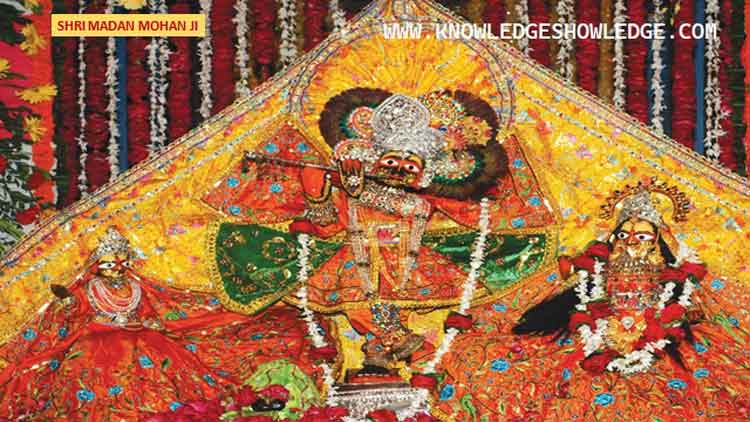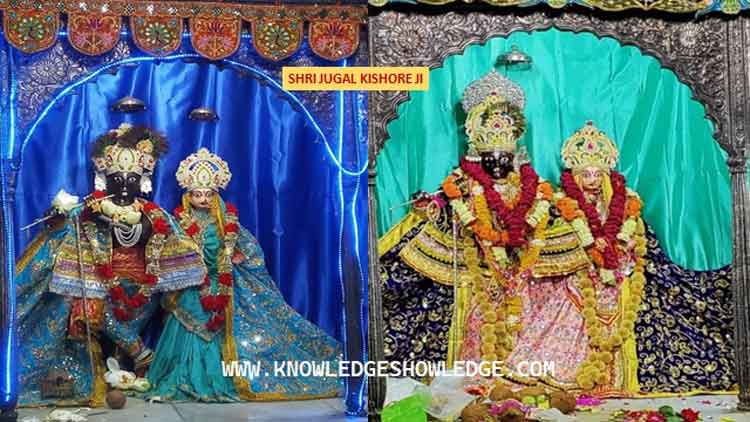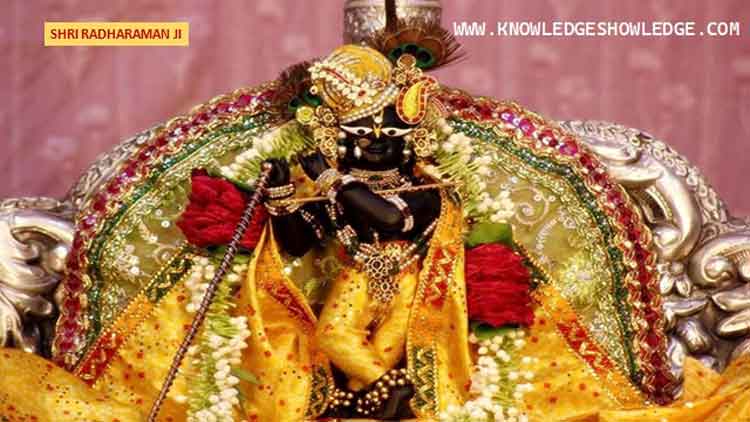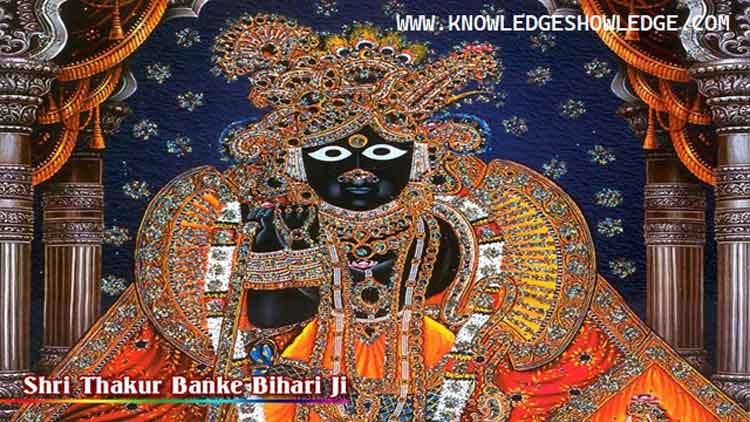Table of Contents
Vrindavan – An Introduction (Sapta Nidhi)
Lord Krishna used to spend his leisure time here. The books Harivanshpuran, Shrimad Bhagwad, Vishnu Puran, and others have descriptions of the splendour of Vrindavan. This was mentioned by Kalidas in Raghuvansh when he introduced Shurasenadhipati Sushen in the context of Indumati-Swayamvara. This provides insight into the existence of Vrindavan’s exquisite gardens during Kalidas’s reign.
According to Srimad Bhagwad, Nandji moved to live in Vrindavan with his family and relatives in order to flee the horrors committed by Kansa from Gokul. The Vishnu Purana mentions this episode. Krishna’s activities in Vrindavan are also recounted in the Vishnu Purana. Currently visible as reserved forests are Tatiya Sthan, Nidhivan, Seva Kunj, Madanter, Bihari ji’s garden, and Lata Bhawan (garden with the ancient name Tehri).
In Vrindavan, there are over 5,000 large and small temples. A few temples date back hundreds of years. Mahaprabhu Chaitanya had found numerous temples here in 1515. Numerous temples have been demolished and numerous new ones have been constructed since then.
15 kilometres from Mathura is the significant pilgrimage site of Vrindavan. The activities of Lord Krishna immediately spring to mind when the name Vrindavan is mentioned. He wrote a Raas with the Gopis in this woodland, where he also enchanted Radha. A manifestation of Lord Shiva, Lord Chaitanya Mahaprabhu, unearthed the sacred sites of Vrindavan that had been lost to the passage of time. In the year 1515, Chaitanya Mahaprabhu arrived in Vrindavan.
At the start of the 16th century, Chaitanya Mahaprabhu gave orders for his two most devoted followers, Roop and Sanatan, to settle in Vrindavan. Later, Jeevagoswami, Radhunath Bhatt, and Gopal Bhatt joined him there. South Asian Vaishnav devotees arrived in Vrindaavan. He prospered here to such an extent that all the best Indian metal artisans came here to stay for a while. The Vrindaavan Research Institute, which studies Indian civilization in general and Brij culture in particular, was founded here in 1968.
Also Read: Amazing Biography of Lord Krishna That Will Surprise You | Life History of Lord Krishna

Chronology of Six Gosvamis
- 1486 Sri Chaitanya appeared.
- 1488 Sanatan Goswami appeared.
- 1489 Rupa Goswami appeared.
- 1494 Rahunath Raghunath Goswami appeared.
- 1503 Gopal Bhatt Goswami appeared appeared.
- 1505 Raghunath Bhatt Goswami appeared.
- 1505 Lord Chaitanya retired.
- 1513 Jiva Goswami appeared.
- 1515 Lord Chaitanya’s Vrindavan darshan.
- 1531 Raghunath Bhatt Goswami came to Vrindavan.
- 1534 Lord Chaitanya Mahaprabhu became invisible.
- 1535 Jiva Goswami came to Vrindavan.
- 1542 Radha Damodar Aradhya, first service puja.
- 1542 Radha Raman Aradhya, first service puja.
- 1545 Jeeva Goswami bought land in Radha Kund.
- 1552 Roop Goswami wrote Bhakti Amrit.
- 1558 Sanatan Goswami disappeared.
- 1558 Land acquisition in Radha Damodar.
- 1564 Roop Goswami disappeared.
- 1570 Emperor Akbar met Jeeva Goswami in Vrindavan.
- 1571 Raghunath Das Goswami became invisible.
Also Read: Mahamantra of Kaliyug | Great Hare Ram Hare Krishna Mantra | Harinam
Major Temples in Vrindavan
- Radha Madan Mohan Temple
- Govind Dev Temple
- Radha Gopinath Temple
- Radharaman Temple
- Radha Damodar Temple
- Radha Gokulanand Temple
- Radha Shyam Sundar
- Banke Bihari Temple
- Radha Vallabh Temple
- Krishna Balram (ISKCON) Temple
Sapta Nidhi (7 idols of Lord Krishna), Vrindavan
Today we are telling you about Sapta Nidhi (7 idols of Krishna), which are related to Vrindavan Dham. Out of these 7 Shrivigrahs, 3 are still installed in the temples of Vrindavan Dham, while 4 are established at other places –
Lord Govind Dev Ji, Jaipur

Roop Goswami received this Shri Vigraha from a place called Gauma Tila in Vrindavan. Found in 1592 (1535). He installed this Srivigraha in a small hut at the same place. After this, Raghunath Bhatt Goswami took over the service and worship of Govindji, during his time Amer King Mansingh built a grand temple of Govindji. Govind ji sat in this temple for 80 years. During the attack on Braj during the reign of Aurangzeb, Govindji was taken to Jaipur by his devotees, since then Govindji is present in the royal (palace) temple of Jaipur.
Lord Madan Mohan Ji, Karauli

Also Read: Amazing Facts Behind Lord Krishna 16108 Wives & Their Previous Birth
This Shrivigraha was received by Advaitaprabhu from Dwadshaditya mound near Kalidah in Vrindavan. He handed over this Shrivigrah to a Chaturvedi family of Mathura for service and worship and after asking from the Chaturvedi family, Sanatan Goswami gave it to V.S. Established again in 1590 (1533) on the same mound of Vrindavan. Later, a massive Madanmohanji temple was constructed here by the king of Orissa and the salt merchant Ramdas Kapoor of Multan. During the Mughal invasion, devotees also took him to Jaipur, but later, King Gopal Singh of Karauli built a big temple near his palace and installed Madanmohanji. Since then Madan Mohanji has been giving darshan in Karauli (Rajasthan).
Lord Gopinath Ji, Jaipur

Also Read: 12 Success Tips from Lord Krishna as per Bhagawad Gita
Saint Parmanand Bhatt found this idol of Lord Krishna at Vanshivat on the banks of Yamuna and he placed this idol near Nidhivan and handed over its service and worship to Madhu Goswami. Later, Raisal Rajputs built a temple here but during the invasion of Aurangzeb, they were also taken to Jaipur, since then Lord Gopinathji is present in the Gopinath temple located in Purani Basti there.
Lord Jugal Kishore Ji, Panna

This Shrivigrah of Lord Shri Krishna was given to Hariramji Vyas by V.S. Found on Magh Shukla Ekadashi of 1620 at a place called Kishorevan in Vrindaavan. Vyasji established that Shrivigraha there. Later, King Madhukar Shah of Orchha built a temple near Kishorevan. Lord Jugal Kishore remained here for many years and at the time of Mughal attack, his devotee Jugal Kishore took him to Panna near Orchha. Even today people are giving darshan in the old Jugalkishore temple in Panna (Madhya Pradesh).
Lord Radharamanji, Shri Vrindavan Dham

Srila Gopal Bhatta Goswami found a Shaligram rock in the Gandak River. They brought it to Vrindaavan and enshrined it in the temple near Kesighat. Unable to wear the clothes given by the devotee and one day a visitor sarcastically said that Shaligram ji looks like brinjal in curry when applied with sandalwood. Goswamiji was very sad to hear this but as soon as the morning came, the divine idol of Lord Radharaman appeared from Shaligram. This day V.S. It was on Vaishakh Purnima of 1599 (1542 AD). His enshrinement no. in the present temple. Made in 1884.
Despite the Mughal attacks in Sri Vrindaavan Dham, this is the only idol which did not go out of Vrindavan and was kept hidden by the devotees in Vrindavan itself. The most special thing is that on Janmashtami, where in all the Krishna temples of the world, festive worship and aarti are held at 12 o’clock in the night, the birth consecration of Radha Manji takes place at 12 o’clock in the afternoon. It is believed that Thakurji is very gentle and it is okay to wake him up at night. No.
Lord Radhaballabh Ji, Vrindavan Dham

Harivanshji had received this idol of Lord Krishna as dowry. While coming to Vrindavan from Deoband, he was married to the daughter of Atmadev Brahmin in Chatthawal village. Radha Ballabhji was established first in Seva Kunj of Vrindavan (Samvat 1591) and later in the old red stone temple built by Sunderlal Bhatnagar (some people give this credit to Rahim).
During the Mughal attack, devotees took him to Cama (Rajasthan). V.No. In 1842, once again the devotees brought this Shrivigraha to Vrindavan and installed it in the newly constructed temple here, since then Lord Radhaballabhji ji resides here.
Lord Banke Bihari Ji, Shri Vrindavan Dham

Also Watch: How to Make Lord Vishnu Happy?
On Margashirsha Shukla Panchami, Lord Banke Bihariji appeared in Nidhivan to give a concrete form to the devotion and worship of music’s chief acharya Swami Haridasji Maharaj. Swamiji established this Srivigraha there. During the invasion of Mughals, devotees took him to Bharatpur. At the place named Bharatpurwala Bagicha of Vrindavan, V.S. When the temple was constructed in 1921, Banke Bihari once again became established in Vrindavan and since then he has been giving darshan to the devotees here.
The main specialty of Lord Bihariji is that the feet of Thakur are seen here only once in a year, Thakur wears Banshee only once in a year. Mangala Aarti is performed here only one day in a year (in the morning after Janmashtami), whereas in Vaishnav temples there is a tradition of Mangala Aarti being performed daily in the morning.
